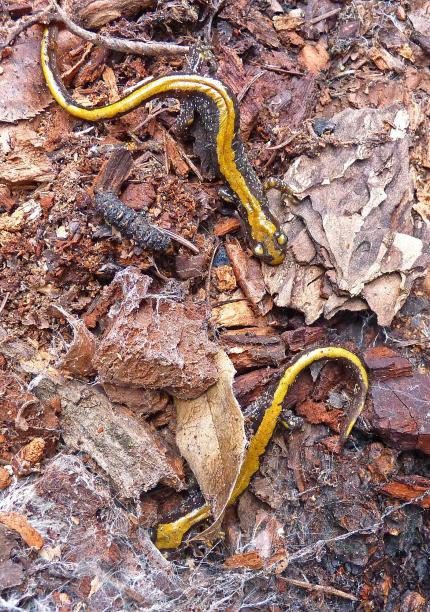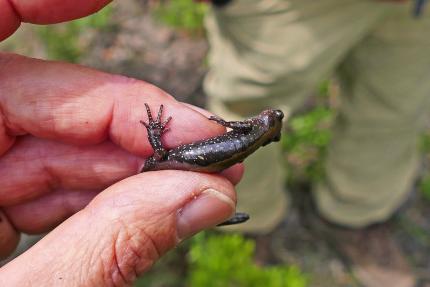These are the most widespread and, frequently, the most abundant salamander species encountered in Washington. They do not appear to require special conservation actions at this time.
According to NatureServe, the state conservation status of the long-toed salamander population is considered “secure” in Washington. However, historically introduction of salmonid fishes, especially brook trout, to a broad range of high elevation lakes, may have resulted in lower abundance and occupancy of long-toed salamanders in those systems.
Description and Range
Physical description
This is a medium-sized dark gray or black salamander with an irregular yellow, olive or green dorsal stripe, distinct costal grooves, a broad head and rounded snout. Adults range in size from 2.13 to 3.25 inches snout to vent length. The dorsal stripe is often irregular and broken into spots. The sides of the body have blue or white speckling. The underside is black or gray. The tail is laterally compressed. The common name refers to the unusually long fourth hind toe (next to the outer-most toe). During the breeding season males have a swollen vent.
Larvae
Hatchlings are 0.24 to 0.5 inches total length and have balancers (rod-like structures on each side of the head). Larvae are typical pond type with large gills and a high tail fin. Gill filaments are “ragged” and uneven in length. The top gill filament is usually longer than the remaining gill filaments on the stalk. Fewer than 13 gill rakers exist on the anterior face of the third gill arch. Larvae rarely exceed 3.35 inches total length. The dorsal stripe develops at metamorphosis.
At hatching, long-toed salamanders have balancers and tiger salamanders do not. Otherwise, the small larvae (less than 2 inches total length) of the three species of mole salamander (Genus Ambystoma) native to Washington are similar in appearance. With experience, one can recognize differences in the gills, the way the larvae hold their gills, head size, head shape and coloration. Differences are subtle and may not be obvious to the novice.
Larger larvae are easier to distinguish. Tiger salamander and northwestern salamander larvae grow larger (greater than 3 inches total length, 1.4 inches snout to vent length) and develop huge gills and robust legs and toes. Tiger salamander larvae have more than 13 gill rakers on the anterior face of the third gill arch. Northwestern salamander larvae have glandular patches on the head and tail.
Eggs
Both single eggs and egg masses may be present at the same breeding site. Single eggs may be spread throughout the habitat or clustered in small clumps on vegetation. The egg masses typically contain 10 to 20 eggs, but smaller or larger clusters are common. Individual eggs (ovum and gelatinous envelope together), whether laid singly or in a mass, measure 0.4 inches or greater in diameter. The ova are approximately 0.07 to 0.1 inches diameter, with dark animal poles and gray or white vegetal poles. Except in newly laid eggs, the gelatinous envelope is loose and watery and does not hold its shape out of water. Development time to hatching is 2 to 5 weeks depending on water temperature.
Tiger salamanders and rough-skinned newts lay small single eggs (ovum and gelatinous envelope together) that are less than 0.4 inches in diameter when fully expanded. Pacific treefrogs and Great Basin spadefoots have egg masses that are similar, but both species have individual eggs (ovum and gelatinous envelop together) that are 0.2 inches or less in diameter when fully expanded.
For more details about the long-toed salamander, see the Washington Herp Atlas.
Check out this short video about long-toed salamander.
Ecology and life history
Long-toed salamanders use a variety of habitats and persist in many urban and disturbed areas. Terrestrial habitats include sagebrush communities, coniferous forest, ponderosa pine – Oregon oak and alpine meadows. Eggs and larvae have been observed in wetlands, ponds, lakes, slow flowing springs, road ditches, spring boxes, large puddles and other types of seasonal pools.
Long-toed salamander are typically sparse or absent from water bodies with fish, although this varies with habitat complexity. Transformed salamanders spend most of their lives underground except when migrating to and from breeding sites. They are thought to be poor burrowers and may generally depend on interstitial spaces between rocks or where roots, rotting wood, or the tunnels of other animals allow easy underground access.

While surface active in the spring, they seek refuge under decaying logs, loose bark, rocks and other structures that retain moisture. Overwintering habitat in Washington has not been described but is most likely subterranean.
Long-toed salamanders in lowland areas of western Washington start breeding as early as January. In the Columbia Basin, egg laying takes place primarily in March and April. Breeding at higher elevations starts later and timing varies depending on elevation and site conditions.
Egg laying behavior, with eggs being laid both singly and in masses, is highly variable. Some variability is geographic and may reflect incomplete understanding of long-toed salamander systematics. Eggs may be attached to vegetation, the underside of logs or laid unattached on bare sediments.
Egg development time to hatching is two to three weeks depending on water temperature. The length of the larval period is variable depending on site conditions; food resources and temperature appear to strongly influence differences.
Metamorphosis takes place in the summer or fall of the first year. At high elevations, larvae may overwinter and transform the following year.
Geographic range
In Washington, long-toed salamanders are the most widespread, possibly the most common salamander species and occur in all ecoregions. Occurrences are sparse in coastal areas of the Pacific Northwest Coast Ecoregion and in the driest portions of the central arid shrub-steppe zone of the Columbia Basin Ecoregion.
This map from the Washington Herp Atlas illustrates the distribution of long-toed salamander in Washington based on records in the WDFW database as of 2016. If you see this species in areas that are not indicated on the map or have more recent observations (less than 10 years), please share your observation using the WDFW wildlife reporting form.
For a map of range-wide distribution and conservation status of this species, check out NatureServe Explorer and the International Union for Conservation of Nature Redlist.
Regulations
Licenses and permits
Be advised that collection of this species is only permitted under a WDFW Scientific Collection Permit for research and educational activities.
Conservation
The state conservation status of the long-toed salamander is “secure” based on the assumption that it is common according to the most current records.

Larval abundance is reduced or eliminated in alpine lakes with introduced trout. This should be considered before non-native fish are introduced to long-toed salamander breeding habitats. Similar patterns may be occurring in lowland systems, but except for localized study, are unexamined to date.
Specific inventory needs do not appear to be pressing at this time; however, as long-toed salamanders seem to have a relatively low tolerance for co-occurrence with predatory fishes, especially exotic species, a better understanding of this phenomenon in context of their current distribution is needed.
Several warm water fish species, now widespread in lowland habitats in Washington, appear to have negative interactions with other amphibians, but their impacts on long-toed salamanders are largely unstudied. One potential effect of these introductions is that long-toed salamanders may use more temporary water bodies (such as small, isolated wetlands) for breeding than occurred historically because the exotic species occupy the permanent water bodies. This deserves study.
Resources
References
Adams, M. J. 1999. Correlational factors in amphibian declines: Exotic species and habitat change in western Washington. Journal of Wildlife Management 63(4):1162-1171.
Adams, M. J., C. A. Pearl, and R. B. Bury. 2003. Indirect facilitation of an anuran invasion by non-native fishes. Ecology Letters 6(4): 343-351.
Corkran, C. C. and C. Thoms. 1996. Amphibians of Oregon, Washington and British Columbia. Lone Pine, Redmond, Washington. 175 pp.
Duelman W. E. and L. Trueb. 1986. Biology of Amphibians. The John Hopkins University Press, Baltimore. 670 pp.
Hallock, L. A. 1998a. Amphibian Inventory of the Cow Creek Watershed, Lincoln and Adams counties, Washington. Unpubl. Rep. Wash. Natural Heritage Program, Dept. of Natural Resources, Olympia. 11 pp. + appendices.
Hallock, L. A. 1998b. Herpetofauna of the Hanford Nuclear Reservation, Grant, Franklin and Benton Counties, Washington. Unpublished report submitted to The Nature Conservancy, Seattle, WA. 43 pp + appendices
Hallock, L. A. 1998c. Herpetofauna Inventory of Bureau of Land Management sites in Douglas, Franklin, Grant, Lincoln, Klickitat, Washington. Unpubl. Rep. Wash. Natural Heritage Program, Dept. of Natural Resources, Olympia. 14 pp. + appendices.
Leonard, W. P., H. A. Brown, L. L. C. Jones, K. R. McAllister and R. M. Storm. 1993. Amphibians of Washington and Oregon. Seattle Audubon Society The Trailside Series, Seattle, Washington. 169 pp.
Nussbaum, R. A., E. D. Brodie, Jr., and R.M. Storm. 1983. Amphibians and Reptiles of the Pacific Northwest. University of Idaho Press, Moscow, Idaho. 332 pp.
Petranka, J. W. 1998. Salamanders of the United States and Canada. Smithsonian Institution Press, Washington, D.C. 587 pp.
Stebbins. R. C. 2003. A Field Guide to Western Reptiles and Amphibians, 3rd Edition. The Peterson Field Guide Series. Houghton Mifflin Company, Boston. 533 pp.
Tyler, T., W. J. Liss, L. M. Ganio, G. L. Larson, R. Hoffman, E. Deimling, and G. Lomnicky. 1998. Interaction between introduced trout and larval salamanders (Ambystoma macrodactylum) in high-elevation lakes. Conservation Biology 12:94–105.
Tyler, T. J., W. J. Liss, R. L. Hoffman, and L. M. Ganio. 1998. Experimental analysis of trout effects on survival, growth, and habitat use of two species of Ambystomatid salamanders. Journal of Herpetology 32:345-349.
Personal communications
Marc Hayes, Washington Department of Fish and Wildlife, Olympia, Washington.
WDFW publications
WDFW educational resources
- Wild Washington Lesson Plan – Herps in Washington: Elementary school students are introduced to the cold-blooded world of reptiles and amphibians, also known as herps.
- Family Education - Amphibians and Reptiles: Slither, hop, or crawl on over to learn about herpetofauna!